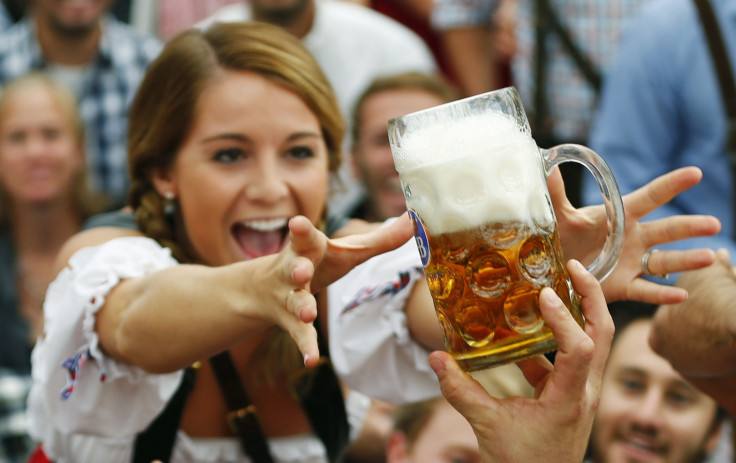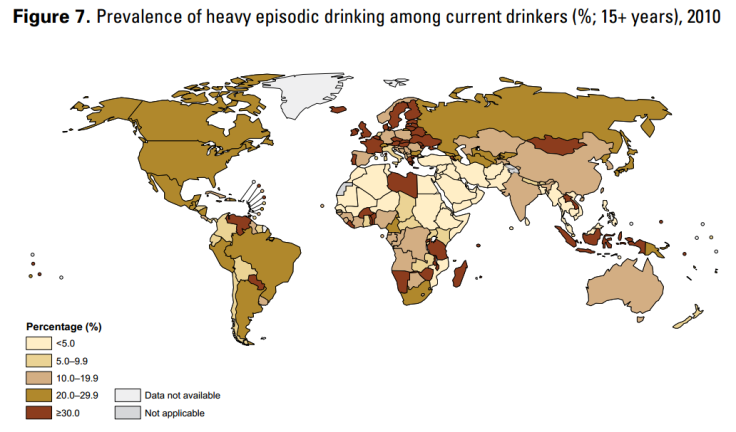WHO Global Alcohol Report: What Kills 3.3 Million Of Us Per Year And Which Country Drinks The Most

Some 3.3 million people worldwide died in 2012 from “harmful use of alcohol," the World Health Organization reported Monday. That was 5.9 percent of all deaths worldwide.
(You can search for reports by country here and read the full report here. Read the United States' report here.)
The WHO measured alcohol consumption based on the equivalent of liters of pure alcohol consumed. On average, each of the 38.3 percent of people over 15 years old worldwide who drink consume 17 liters (4.4 gallons) of pure alcohol per year. That’s around 44 ml (1.5 oz) every day.
Of course the question isn’t so much the quantity people drink, but how they do it. According to the WHO, alcohol-related harm is determined by the volume consumed, pattern of drinking and to a lesser extent the quality of alcohol. A glass of wine at dinner isn’t a big deal; it's binge-drinking and chronic alcoholism that are killing people.
“We found that worldwide about 16 percent of drinkers engage in heavy episodic drinking – often referred to as ‘binge-drinking’ – which is the most harmful to health,” said Dr. Shekhar Saxena, director for mental health and substance abuse at WHO.
The report did not find a strong correlation between alcohol consumed per capita (APC) and heavy episodic drinking (HED). This figure shows the levels of APC by country:

And this one shows the prevalence of HED:

So who’s the heaviest drinkers? It’s not as simple as what country drinks the most per capita or levels of heavy episodic drinking. Portugal drinks significantly more than any other Western European country, and Germany has a long history of beer drinking, but the WHO rates drinking patterns in them as “least risky” on a scale of 1 to 5, 1 being the least risky and 5 being most. They also share low instances of alcohol use disorders and dependence, about 1 in 20 and one in 33, respectively for both countries.
Eastern Europe and Russia form the biggest concentrated group of heavy-drinking countries. Belarusians appear to be the most formidable drinkers as far as liters consumed and frequency of disorders or dependence. In 2010, 16 percent of Belarusians (29 percent of males, 5.5 percent of females) older than 15 had some sort of alcohol use disorder like dependence. The prevalence of disorders in Hungary is comparable, but the WHO rates Hungarians as drinking more safely.
Regardless of how risky each of these countries' drinking patterns are, they all scored 5 on a scale of 1 to 5 for years of life lost due to alcohol. The WHO accounts for alcohol-related traffic accidents and alcohol-related diseases like liver cirrhosis in that statistic.
Worldwide, alcohol accounts for 7.6 percent of men’s deaths and 4 percent of women’s deaths. Men drink significantly more worldwide than women: Half of all men drink, where only 28 percent of women drink, and one in five men binge while only one in every 20 women binge. The WHO found that poorer people are more heavily affected by the harmful effects of alcohol because of a lack of access to proper health care and solid family support structures.
On the other end of the spectrum, 61.7 percent of people over 15 had not drunk in the last 12 months. Over the last five years, drinking has remained somewhat stable in Africa, Europe and particularly the Americas. It has grown in Southeast Asia and Pacific, mostly in India and China, which the WHO says could be because of increased marketing and higher incomes.
The WHO calls its 194 member countries to take more steps to reduce drinking, like taxing alcohol more and fighting illegal alcohol production, which makes up a quarter of all alcohol consumed. The WHO hopes to reduce harmful drinking by 10 percent by 2025.
© Copyright IBTimes 2024. All rights reserved.






















